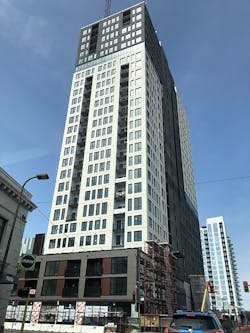Introduction:
Two blocks from the Mississippi River is one of Minneapolis’s busiest streets and the site of the new designer-residential tower “Rafter.” Rafter is a 26-story, luxury high-rise apartment with retail space along Hennepin Avenue.
As part of the new development, the engineering firm, Elan Design Lab of Minneapolis in conjunction with the developer, Mortenson Company, maximize on the high-value buildable space, creatively accommodating traffic levels while complying with drainage and stormwater management standards required by the City of Minneapolis.
Situation:
The heart of downtown consist of virtually all impervious surfaces, including this development’s surroundings. The city’s conventional pollutant byproducts like oils, grease, phosphorus, nutrients, and heavy metals are expected to accumulate. To prohibit the negative environmental impact, developers are required to implement proven stormwater management systems that collect contaminated water runoff.
According to the Minnesota Pollutant Control Agency, “Urban development can significantly impact watersheds by increasing runoff and pollutant loading. Moreover, there’s increasing concern about the quality of Minnesota’s groundwater, which supplies drinking water for three-fourths of the state’s population... our lakes, streams and ground waters continue to be degraded by pollutants that are carried in runoff. This kind of pollution is called ‘nonpoint-source pollution.’” Minneapolis has made many efforts to control and mitigate hazardous pollutants generated from these impervious areas.
Pollutants related to this property’s use could include:
- TSS (Total Suspended Solids)
- Phosphorus
- Nutrients & Bacteria
- Sediments, Trash & Debris
- Oils & Grease
Challenges:
Many challenges exist around construction and infrastructure design within high-traffic urban areas. Any underground system must be quicker and easier to install, fulfilling a developer’s cost-saving needs, and giving future municipal or private maintenance teams long-term benefits. Once complete, the Rafter Development will see heavy foot and vehicle traffic, challenging maintenance and cleaning teams but also higher volumes of non-point pollutants that will accumulate in any stormwater treatment system.
Solution:
The Kraken stormwater filter was chosen for its unique ability to meet all the site’s challenges. First, the Kraken Filter is a more cost-effective solution, from both an upfront investment standpoint and when weighing long-term maintenance costs. In addition, the Kraken Filter is proven to remove both Total Phosphorus (TP) and Dissolved Phosphorus (DP), making it an ideal choice to address potentially high pollutant concentrations and keep ongoing maintenance to a minimum.
According to David Wright, Bio Clean’s local stormwater advisor, “The Kraken Filter was a great choice for Minneapolis’s stormwater treatment needs due to its high removal efficiencies, low profile (low construction excavation), ease of installation, lower up-front cost, and far easier long-term maintenance. The Kraken also has an automatic draindown feature, so the filters are easier to maintain and the BMP doesn’t become a habitat for mosquitoes.”
Bio Clean’s in-house engineers, Scott Sertich and Mike Sheehan, worked closely and timely with Elan Design Group, to help them handle any technical concerns and design challenges. Ultimately, the highly experienced Veit subcontractor team completed the job, handling the installation efficiently within a 30 - 40 minute window.
Editor's Note: Scranton Gillette Communications and the SGC Water Group are not liable for the accuracy, efficacy and validity of the claims made in this piece. The views expressed in this content do not reflect the position of the editorial teams of Water & Wastes Digest, Water Quality Products and Storm Water Solutions.


